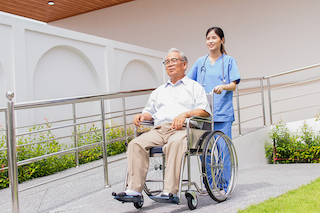 A new study published in the Journal of Rural Sociology looked at the built environmental and social and emotional support among rural older adults and whether there is a case for social infrastructure and attention to ethnoracial differences.
A new study published in the Journal of Rural Sociology looked at the built environmental and social and emotional support among rural older adults and whether there is a case for social infrastructure and attention to ethnoracial differences.
“In this study, we were interested in determining if and how older adult social and emotional health is associated with social infrastructure availability in rural contexts,” study author Danielle Rhubart told us. “Social infrastructure refers to the physical places in a community where people can meet, connect, gather, or simply run into each other. These include places like libraries, coffee shops, hair salons and barber shops, and diners."
The research team drew on the concepts of social cohesion and social support to help explain this relationship. Social cohesion refers to the level of connectedness or social ties within a community. Social support refers to the resources — material, psychological, financial or emotional — available through social networks.
“When there is high social cohesion everyone benefits, even those who may not be overly engaged in those networks,” Rhubart told us. “Social cohesion has been linked to a number of community- and individual-level benefits. We hypothesize that social infrastructure can provide the foundation for strong social cohesion, which can in turn promote social and emotional support among older adults.”
Older adults often experience constricting social support networks as they leave the workforce, face mobility challenges, and experience the passing of close friends and family members. This can be even more challenging in rural areas where populations are more dispersed and public transportation is less likely to be available.
At the same time, social infrastructure plays an important role in fostering social connection in communities.
“Understanding if and how social and emotional support among older adults varies across places with varying levels of social infrastructure availability is important as we think about potential community-level strategies to support the social, emotional and mental health of an aging population,” Rhubart told us, “especially in rural areas which are home to disproportionate shares of older adults.”
Researchers used data from the Behavioral Risk Factors Surveillance System (BRFSS) and the National Neighborhood Data Archive (NaNDA) to examine the relationship between individual-level social and emotional support and county-level availability of social infrastructure. They also ran separate models by race and ethnicity to determine if and how the relationship varied.
The results show that for rural Hispanic and Black older adults, those who live in counties with higher availability of social infrastructure are more likely to have their social and emotional support needs met compared to those who live in counties with lower availability of social infrastructure.
“These findings were only present in the models for Blacks and Hispanics, and not for the non-Hispanic White model,” Rhubart told us. “In the discussion of the paper, we hypothesize why this might be. The idea that social cohesion can benefit all within a community may – generally speaking - not hold true for those who are more isolated, such as home-bound older adults in rural areas.”
But ethnoracial differences in social networks among older adults may explain why the concept of social cohesion and the relationship between social infrastructure and social and emotional support did hold true for ethnoracial minority older adults. For example, previous work has shown that respite and care taking of extended family is more common among Hispanic populations. And both Black and Hispanic population are – on average – more likely to interact with their social networks and with non-kin ties in their community. So for Black and Hispanic older adults, these factors may keep them connected with others in their community and, as a result, allow them to benefit from broader social cohesion facilitated by high densities of social infrastructure.
"Meeting the mental and emotional health needs of older adults – a growing segment of the U.S. population – will require multilevel and multidimensional approaches,” Rhubart told us. “Many of these approaches will need to focus on reinforcing and expanding the social networks and social supports of older adults. Our research here suggests that community-level approaches to strengthen new and existing social infrastructure in rural settings may be one strategy for bolstering social and emotional support among Black and Hispanic older adults.”
Patricia Tomasi is a mom, maternal mental health advocate, journalist, and speaker. She writes regularly for the Huffington Post Canada, focusing primarily on maternal mental health after suffering from severe postpartum anxiety twice. You can find her Huffington Post biography here. Patricia is also a Patient Expert Advisor for the North American-based, Maternal Mental Health Research Collective and is the founder of the online peer support group - Facebook Postpartum Depression & Anxiety Support Group - with over 1500 members worldwide. Blog: www.patriciatomasiblog.wordpress.com
Email: tomasi.patricia@gmail.com